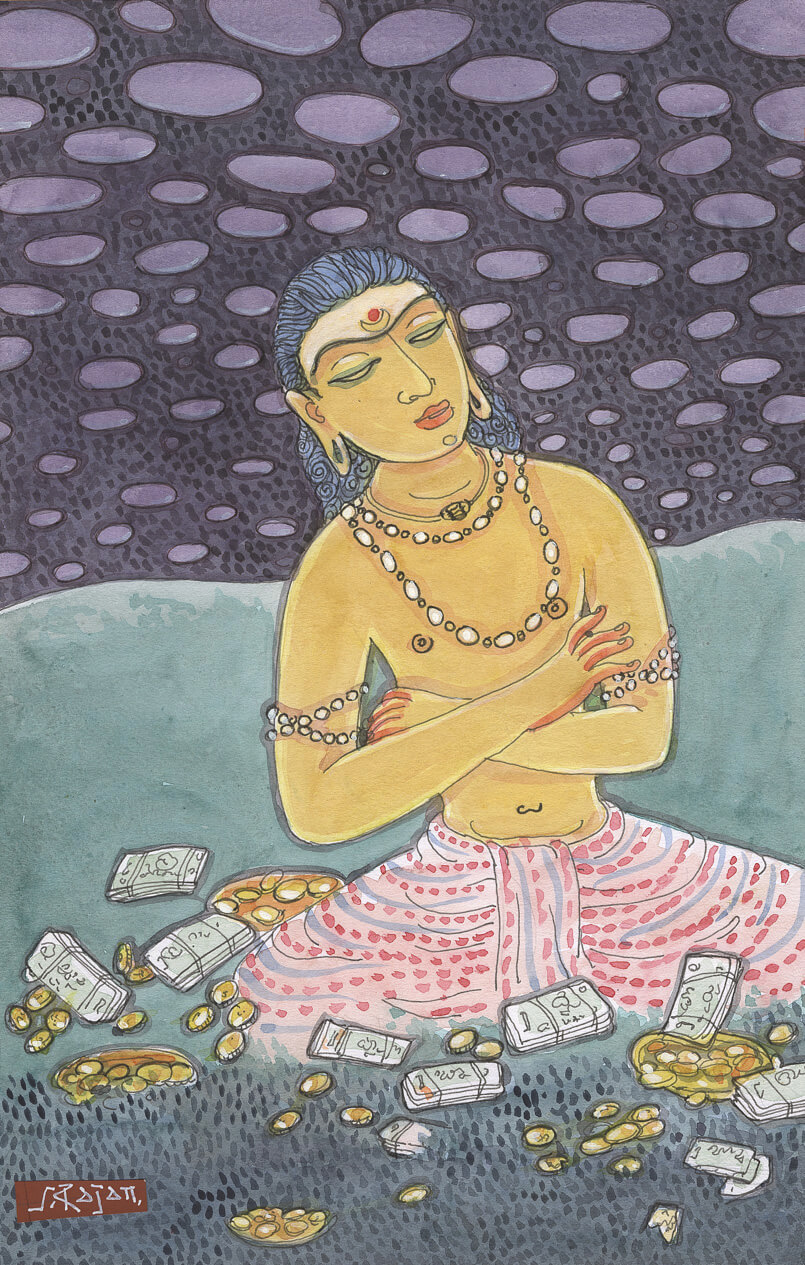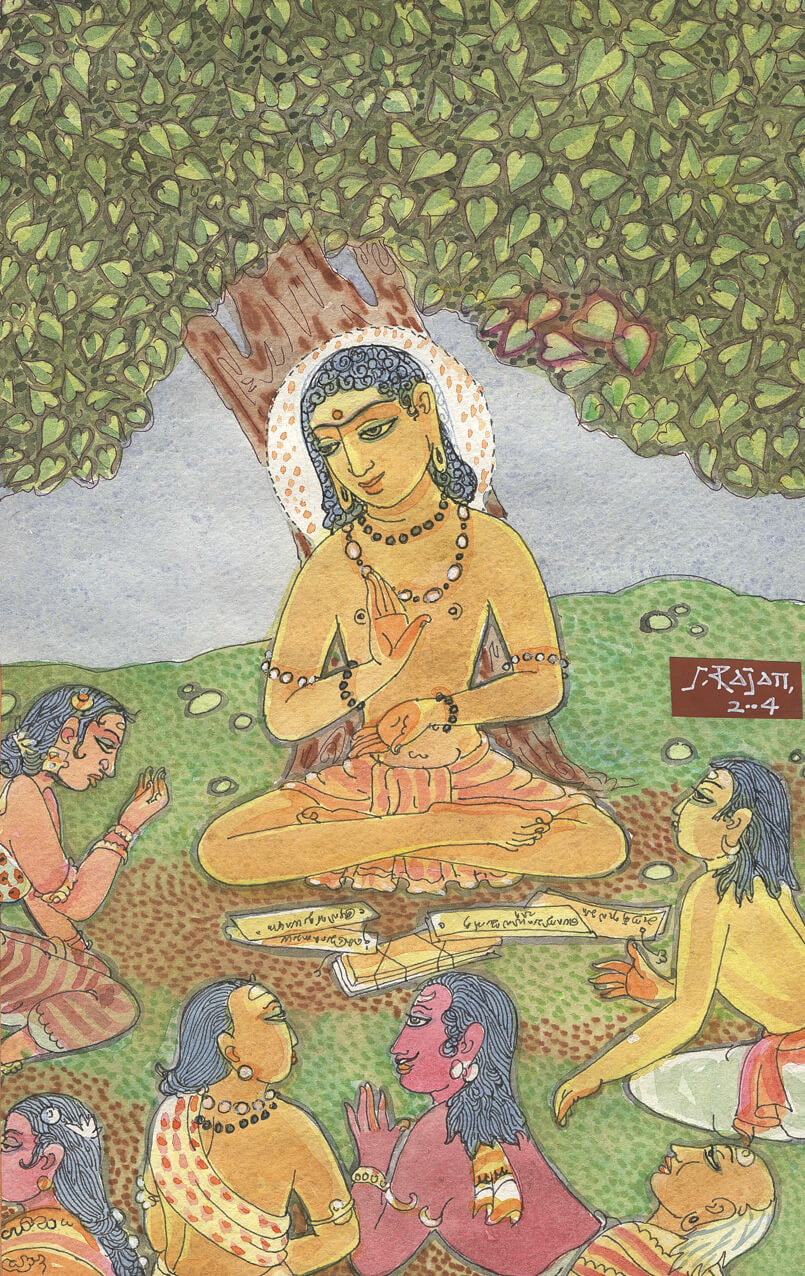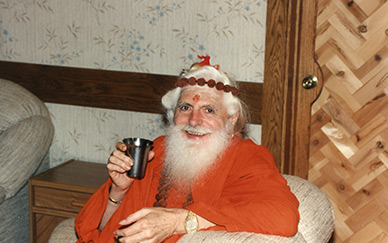An Oceanside Sunrise
A recent sunrise captured by one of our monks
“You are perfect this very moment. You are all that you will ever be.”
– Gurudeva
Tirukural – Chapter 42

Chapter 42: Learning by Listening

Verse his
eyes closed in meditation, a man sits with arms crossed in disdain for the riches that lie before him. The clouds around him represent his guru’s oral teachings, which he is listening to. The bundles of rupee notes and coins are slowly fading from sight. Parts of them have already disappeared as he clings to his guru’s wisdom.
You can access the entire text, in Tamil and English here:
Weaver’s Wisdom
Verse 411
The most precious wealth is the wealth acquired by the ear.
Indeed, of all wealth, that wealth is paramount.
Verse 412
Only when no fare can be found for the ear
is it time to offer the stomach a morsel.
Verse 413
In Heaven, Deities feed from sacrificial fires.
On Earth, men who feast on listening are their equal.
Verse 414
Though he has no learning, if a man listens to the learned,
that will serve as his staff of strength in adversity.
Verse 415
Words from the lips of upright men
are like a steadying staff in a slippery place.
Verse 416
Let a man listen to good things, however little.
Even that little will enlarge his greatness.
Verse 417
Those who have studied deeply and listened diligently never speak
foolish words, even when they have misunderstood a matter.
Verse 418
If not pierced by acute listening,
ears may hear and yet remain deaf.
Verse 419
Unless he has listened to learning’s subtlety,
it is rare indeed for a man to speak with humility.
Verse 420
There are those whose tongues taste but whose ears savor nothing.
What does it matter whether they live or die?
Planting Flower Gardens

Jai Ganesha!
Over the last year, Yogi Dayanatha has spent time gradually adding life and beauty to the area around our monastery's woodfire oven. He's cleared old, shaded foliage and replaced it with rock-encircled mounds of colorful flowers and decorative palm trees. The area now feels open, airy and bright. The array of flowers—which will eventually overflow their beds in polychromatic abundance—include Impatiens, zinnias, marigolds and roses. Aum.
Shum Maps of Meditations – Part 9
Satguru Bodhinatha Veylanswami gives part nine of a series of talks which give insight and elaboration into a variety of fascinating concepts revealed in the Shum language of meditation. Here, Satguru gives special attention to the 54 mambashum—important areas of the mind detailed by Shum.
Kauai’s Hindu Monastery Newsletter – June 2021

Click here to view our June 2021 Newsletter: www.himalayanacademy.com/monastery/newsletter
From Darkness into Light

Mark Twain's Favorite Brewery
[This is a story from The Guru Chronicles]
Following a 1962 summer retreat at Angora Lake, Gurudeva visited nearby Virginia City, Nevada, to find a piece of property that could serve as a permanent retreat center. He didn't have to look far. About a quarter mile down the canyon from this legendary boom town of the Old West, he found a large, ramshackle brewery, originally built in 1864 on the site of the famed Comstock Lode Gold Rush. It was for sale.
Its austere Sierra Nevada mountain terrain, with its sagebrush and pion pine landscape, something that might intimidate others, was appealing to him. It was yogic, almost desolate. It was a place where the inner was more important than the outer. His first thought, when he stepped inside, was, "What a wonderful ashram this would make!'' He wandered through its cavernous rooms, on three floors, and, despite the dilapidated condition of the landmark, he arranged to purchase it.
The building, known as the Old Nevada Brewery, was the favorite haunt of American humorist Mark Twain. Samuel Clemens (Twain's real name) was first a writer and then the editor of the Territorial Enterprise in Virginia City from 1862 to 1864, a time during which he wrote his famed novel Roughing It. Each afternoon, it is said, he took refuge in the beer gardens of this biggest and most popular pub, telling tall tales to rowdy miners. And there were large crowds. In those days, Virginia City, with 30,000 people, was nearly half as populous as San Francisco, due to the gold rush which brought people from all over the world to the Wild West to dig into the sage-covered hills.
The landmark had been a silent memorial for half a century when Sivaya Subramuniyaswami, the new owner, stepped into its brick and fancy-woodwork rooms. Its age was showing. The resident caretaker was a grizzled old prospector who kept his mule in the basement and a pig in the shower. He was hard of hearing and required more than a little convincing that his residence had indeed changed owners.
The ashram became the Skandamalai Monastery (also called the Mountain Desert Monastery), reflecting Subramuniyaswami's insight that Murugan, Skanda, is the lord of renunciates, who would be its residents.
It would also be home of Comstock House, a major publication and printing facility, and the new center for the burgeoning Himalayan Academy courses and programs. For years, at this remote and desolate mountain aerie, 6,500 feet above sea level, the satguru would train his renunciates and issue forth the teachings of Vedanta, Siddhanta and the Saivite religion through literature, travel programs, seminars and courses.
There is a cave down Six-Mile Canyon Road, perhaps a mile beyond the monastery one of the hundreds of abandoned silver mines that honeycomb the region's hills, but horizontally deeper than most. One can walk for half a mile into its chambers. When Gurudeva discovered the cave one day, he was thrilled, and immediately set up a program for his monks. Most often alone, but sometimes in pairs, he sent them to meditate in the dark chambers. Taking only water, no food, the monk would enter the cave, walk through the long tunnel, dodging the massive wooden sup- ports that prevented cave-ins, until there was no light, then walk some more. Once inside the blackness of this space, he would settle down to stay for a day, for two days, as instructed, rarely more. He was to chant and meditate, nothing else except, and this was the sadhana, to seek the light within, the clear white light of the mind.
Sometimes, when meditating, one does not know if he is seeing the inner light or perhaps seeing the luminous space of the room beyond his closed eyes. But in a cave, deep in the Earth, there is no peripheral light. There is blackness. There is silence. There is nothing else. Monks would dive into themselves in that cave, distracted at first with the random intrusions of recent experience, of their projects back at the monastery, the paucity of food, whatever. But as the hours flowed by, the silence grew, and that silence worked well to bring them into the light of the mind.
And when you see light in a darkened cave, you know it's not coming from anywhere else; it is coming from you.
A few monks returned to speak of extraordinary moments when the light coming from within also illumined the floor and walls of the cave, brightly enough for them to discern details of the tunnel, bright enough for them to walk out without turning on their flashlight. Such was the way of the guru in those days. Gurudeva wrote about the inner light shortly after these cave experiences:
"Remember, when the seal is broken and clear white light has flooded the mind, there is no more a gap between the inner and the outer. Even uncomplimentary states of consciousness can be dissolved through meditation and seeking again the light. The aspirant can be aware that in having a newfound freedom internally and externally there will be a strong tendency for the mind to reconstruct for itself a new congested subconscious by reacting strongly to happenings during daily experiences. Even though one plays the game, having once seen it as a game, there is a tendency of the instinctive phases of nature to fall prey to the accumulative reactions caused by entering into the game.
"Therefore, an experience of inner light is not a solution; one or two bursts of clear white light are only a door-opener to transcendental possibilities. The young aspirant must become the experiencer, not the one who has experienced and basks in the memory patterns it caused. "
Tirukural – Chapter 41

Chapter 41: The Neglect of Learning

Verse 409
A young scholar sits under a tree surrounded by the ancient texts which he knows well. His nobility is such that crowds gather to hear his words.
You can access the entire text, in Tamil and English here:
Weaver's Wisdom
Verse 401
Speaking to a learned gathering without ample knowledge
is like playing a dice game without the board.
Verse 402
An uneducated man desiring to be eloquent
is like a breastless woman longing to be feminine.
Verse 403
Even the ignorant will be considered wise
if they refrain from speaking in the presence of the learned.
Verse 404
However excellent an untaught man's knowledge may be,
erudite men will never accept it.
Verse 405
An unschooled man's self-conceit will shrivel
the moment he speaks to an assembly.
Verse 406
Like unproductive barren land is the man who has neglected
learning. All that can be said about him is that he exists.
Verse 407
The handsome charm of him whose knowledge
is neither subtle nor penetrating is like that of a painted clay doll.
Verse 408
Even more wretched than a learned man's poverty
is the unlearned man's wealth.
Verse 409
Though he is humbly born, a lettered man's nobility
transcends that of the illiterate nobleman.
Verse 410
As men are to wild beasts, so are the masters
of brilliant texts to other men.
Regilding Kadavul’s Kodimaram

Jai Ganesha!
With our team of gold gilders on island working on Iraivan Temple's domes and flagpole, it was the perfect time to regild Kadavul Temple's kodimaram. The full flagpole was just recently finished and is shining brightly in our tropical sun. Aum.
June 2021 Chitra Padapuja
Jai Gurudeva!
Today our monks began their new week with our monthly puja at Gurudeva's shrine in Kadavul Temple. Yogis Dayanatha and Haranandinatha performed the puja and abhishekam. Satguru Bodhinatha Veylanswami and the other monks attended, chanting Sri Rudram and meditating. Aum.
"There is no intrinsic evil. God Siva has created the principle of opposites, which are the means for the soul's maturation--beauty and deformity, light and darkness, love and hate, joy and sorrow." - Gurudeva
A New Roof for Our Woodshop

Jai Ganesha!
Gone are the days of placing buckets under leaks in our wood shop roof. Recently, a hired team completed the installation of new roofing material for the wood shop. The previous roof was made of clear, corrugated, plastic roofing, which over time had succumb to our strong UV and heavy rains. Our new metal roofing should last much longer. It also includes several clear sections as skylights, letting in some sun to keep the shop well lit. Aum.
From Our Gurus' Teachings
Archives are now available through 2001. Light colored days have no posts. 1998-2001 coming later.

